Archival Show and Tell #8
Interwar US Navy Section Colors
by Dana Bell
Interwar US Navy Section Colors |
For decades we’ve all known how the US Navy’s interwar color system worked: there was a hierarchy with Insignia Red assigned to a squadron’s first aircraft section, Insignia White to the second section, True (Light) Blue to the third, Gloss Black to the fourth, Willow (Light) Green to the fifth, and Lemon (Light) Yellow to the sixth. With the section color applied to a chevron above the wing, the cowling, and (for section leaders) a fuselage band, each pilot could easily identify his section and squadron and quickly rejoin formation during and after “combat.”
The problem we have using the system has always been the interpretation of photos. Numerous books have published images that simply don’t seem to fit: in some photos, aircraft from the second section carry markings that certainly aren’t white, while other photos show fourth section aircraft with easily visible black markings on supposedly black section colors.
It was while working on my book on interwar battleship and cruiser aviation that the explanation took shape: documents from the late 1920s and early ‘30s revealed two earlier systems. Here’s what turned up...
In 1925 Battle Fleet’s twelve battleships (organized in three divisions) devised a scheme of colorful identification markings aimed at distinguishing unit aircraft at a distance – it’s important to realize that these were not squadron markings! Each of the three divisions marked its floatplane pontoons in battleship division colors, and each ship in the division marked its aircrafts’ tail in ship identification colors. The first color hierarchy assigned a four-striped tail representing the “division” signal flag to the flagship’s two observation aircraft. Then, with each ship’s order of precedence determined by the captain’s position on the promotion chart, the second ship’s aircraft wore red tails, the third ship’s yellow, and the fourth ship’s white. (A similar color system marked each ship’s turrets, but that discussion must wait for a later telling.)
At the same time, the Navy experimented with detailing TS-1 fighter aircraft to each battleship. The aircraft came from Fighting Squadron One, and in May 1925 squadron commander Ralph Wood, obviously impressed by what he saw on the ships’ observation aircraft, wrote the Bureau of Aeronautics asking permission for his squadron to experiment with similar markings. Initially, Wood applied a system of section colors to the tail of each aircraft, but as VF-2, VF-5, and VF-6 became interested in similar markings, the tail markings switched to squadron colors.
In June 1927 VF-1 reported that the squadron had tested the following colors for each of its four (not yet six) sections in the following order: red, yellow, light blue, and black – all purchased locally. The squadron considered the first three colors satisfactory, but the black paints presented maintenance issues and difficulties “maintaining [a] neat appearance.” VF-1B proposed to substitute green during that summer’s fleet exercises.
Here was the explanation of why tones didn’t match in those vintage black and white photos, which all – as it turned out – were taken before 1930. The second section had used yellow, not white, and some aircraft of the fourth section had used green, not black.
With the number of aircraft assigned to most carrier squadrons increasing to eighteen, in 1930 BuAer and Battle Fleet agreed on the color hierarchy we now remember as standard: red, white, blue, black, green, and yellow. In the interests of consistency, in June 1931 Battle Force (as Battle Fleet had been renamed that April) submitted a chart of proposed colors, all drawn from stocks of the Sewell Paint and Varnish Company. BuAer expected to replace Royal Red with Insignia Red, but listed the Sewell paint as an acceptable substitute. The original Sewell Oriental Blue of the 1920s had been replaced by True Blue – roughly a mix of two parts white to one part Oriental Blue – which was subsequently added to the Army-Navy color charts. (Insignia Blue had been accepted briefly as a replacement, though that mistake was corrected after a few months when both True Blue and Insignia Blue were added to the chart.) Sewell’s Lemon Yellow and Willow Green were also added to the Army Navy standards, though Willow Green was reformulated in 1933. (The Taxi Orange and French Gray were ordered replaced by Orange Yellow and Aircraft Gray.)
The point of all this is that we now know that the variations we see in Navy photos of the late 1920s and early ‘30s weren’t all caused by film and filter differences. We are seeing a period when the Navy played by different, changing sets of rules, and giving us all many more options when painting our kits.
IMAGES:
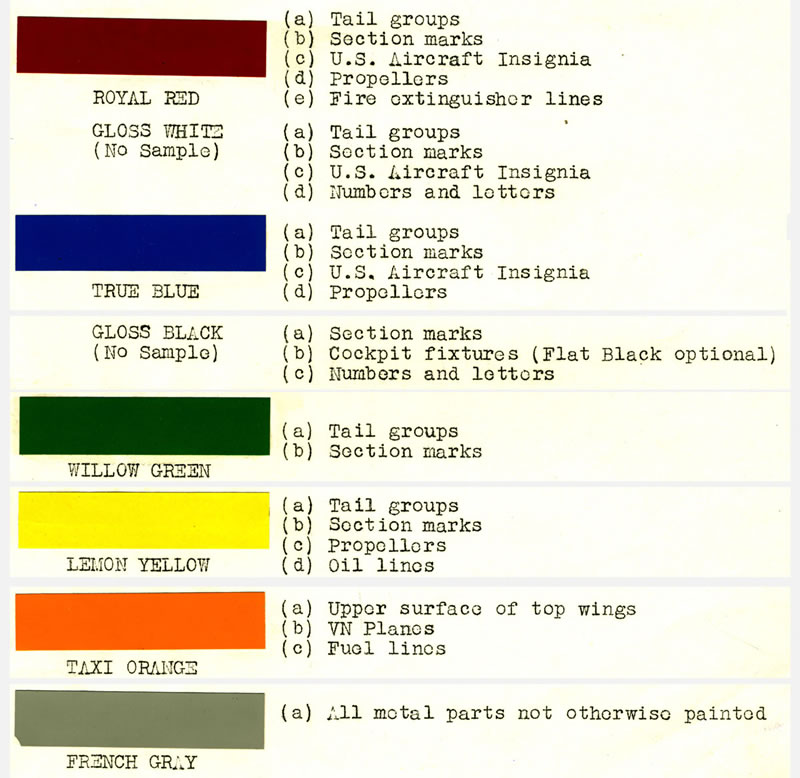
In June 1931 Battle Force submitted this sheet of color chips to BuAer showing the recommended colors and their uses. BuAer revised several of the colors and eventually restored the use of Insignia Blue for national insignia and prop tips. The Sewell paints Willow Green, True Blue, and Lemon Yellow were added to the Army Navy standards, though two years later Willow Green the Naval Aircraft Factory reformulated Willow Green. (In 1941 all three colors were renamed, becoming Light Green, Light Blue, and Light Yellow.)
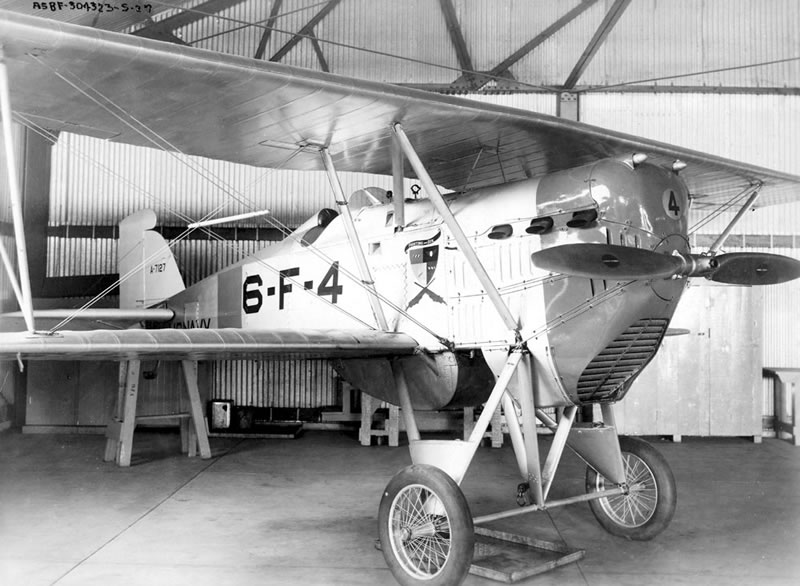
In December 1927 VF-6B submitted this Boeing FB-5 photo as evidence of the squadron’s new unit markings. The squadron’s white tail is seen, but not explained, while the photo caption described the yellow nose and leader’s band for the second section’s leader.
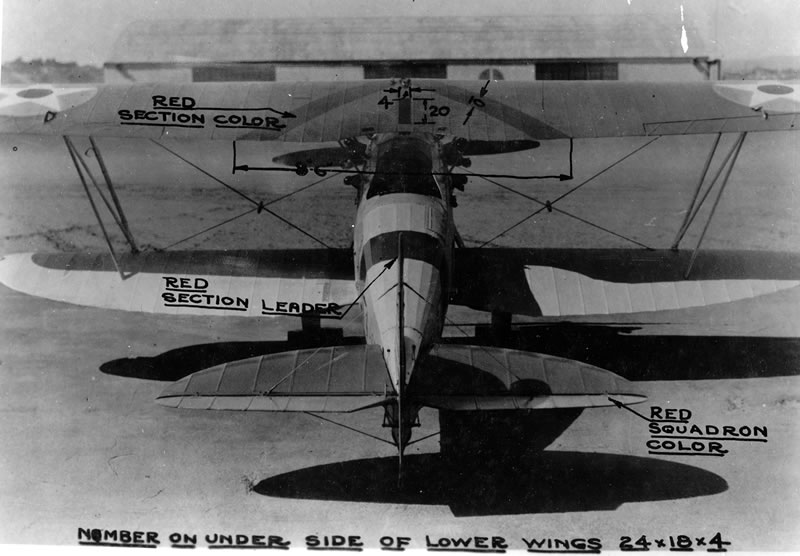
Three months later, in March 1928, VF-1B sent this marked-up image to show their recommended markings for one of their Boeing F2B-1s. Note the mention of underwing codes (in this case 1-F-1 under each wing, with no national insignia). There is no mention of cowl markings, which were apparently introduced in 1929-30.
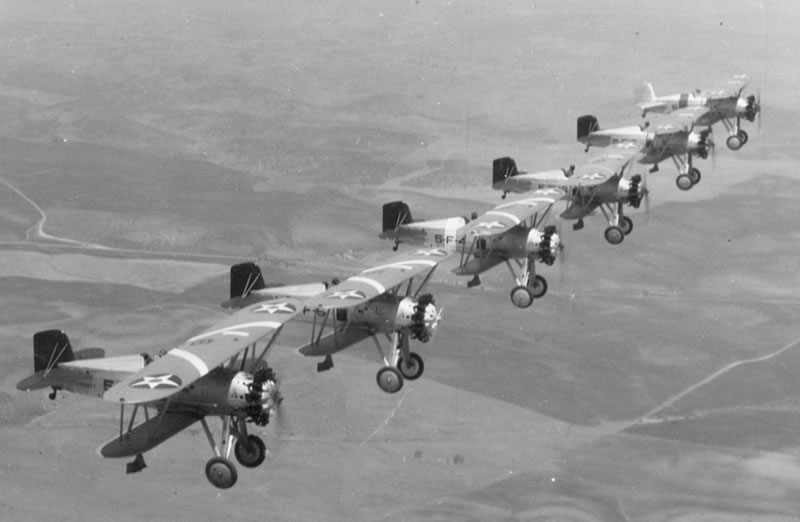
This undated photo shows VF-5B’s F4B-1s in 1929 or ‘30. The engine cowlings (or what we would today consider “nose cowlings”) are painted in section colors, with the entire cowl painted for each aircraft in the section. Note the reversed section-colored chevrons, a common distinguishing feature when two squadrons based similar aircraft on the same field or carrier.
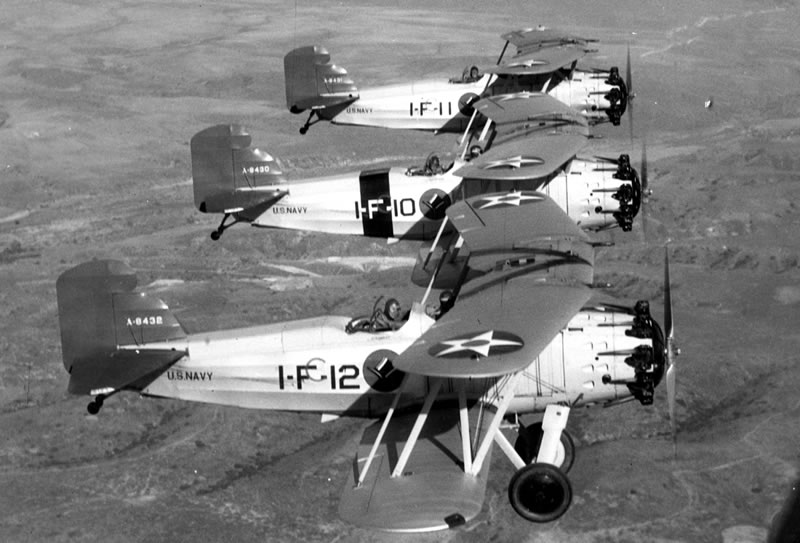
Section 4 of VF-1B Curtiss F8C-4s in mid-November 1930. By now the section color has returned to Gloss Black, as seen on the section leader’s band, chevron, wheel covers, and complete cowling.
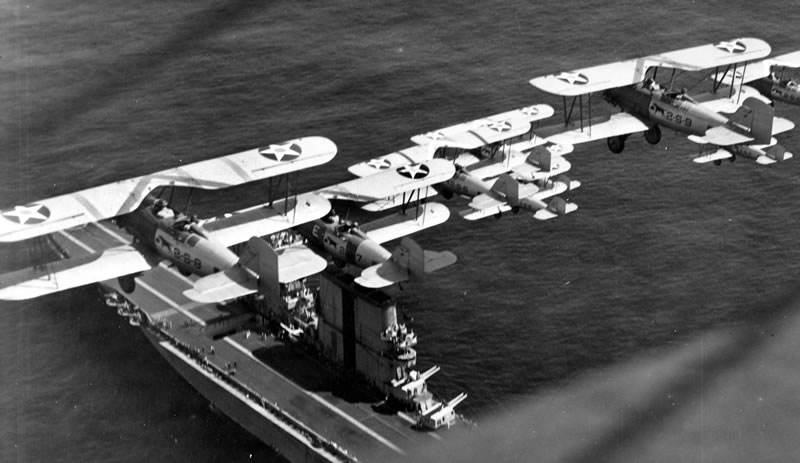
June 1930 and the Vought O2U-2 Corsairs of VS-2B pass over their home ship, the USS Saratoga. Two of the aircraft display parallel bands bracketing the overwing chevrons. Battle Fleet had announced the bands as added section leader identification markings, but neither aircraft (2-S-5 and 2-S-8) was a section leader. On the other hand, 2-S-7 was section 3 leader and has the fuselage stripe but not the extra wing markings. More research is needed here!
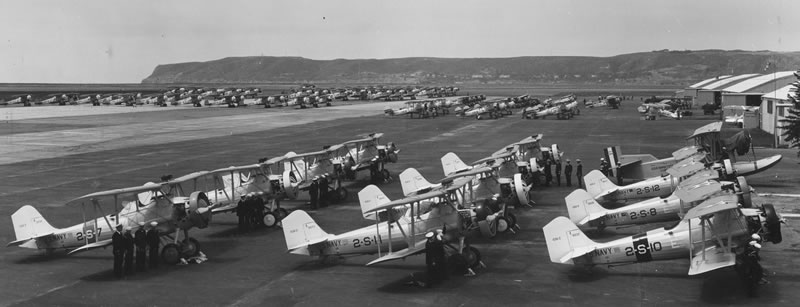
Who would raise a fist against us! Much of the US Fleet’s carrier air power on display at San Diego in May 1932. VS-2B is now flying Vought O3U-2 Corsairs. Revised section markings appear on the nose cowls and ring cowls, with the section leader’s cowls painted completely in the section color, the second aircraft painted only on the top half of each cowl, and the third aircraft only on the bottom half of each cowl.
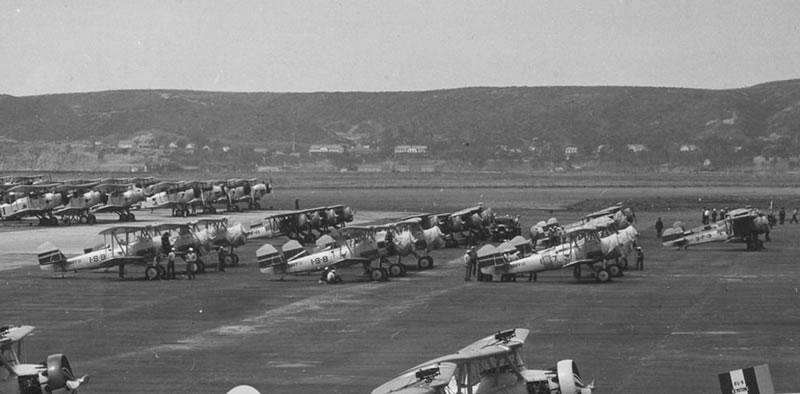
Detail from the background of the previous photo. In May 1932 Langley was still assigned to Scouting Force, which distinguished its aircraft from those of Battle Force by painting squadron-colored bands on aircraft tails (rather than using Battle Force’s complete-tail paint job). Langley returned to Battle Force later in 1932.
Text and Images Copyright ©
2023 by Dana Bell
Page Created 13 March, 2023
Last Updated
14 March, 2023
Back to Reference Library |
Home |
What's New |
Features |
Gallery |
Reviews |
Reference |
Forum |
Search